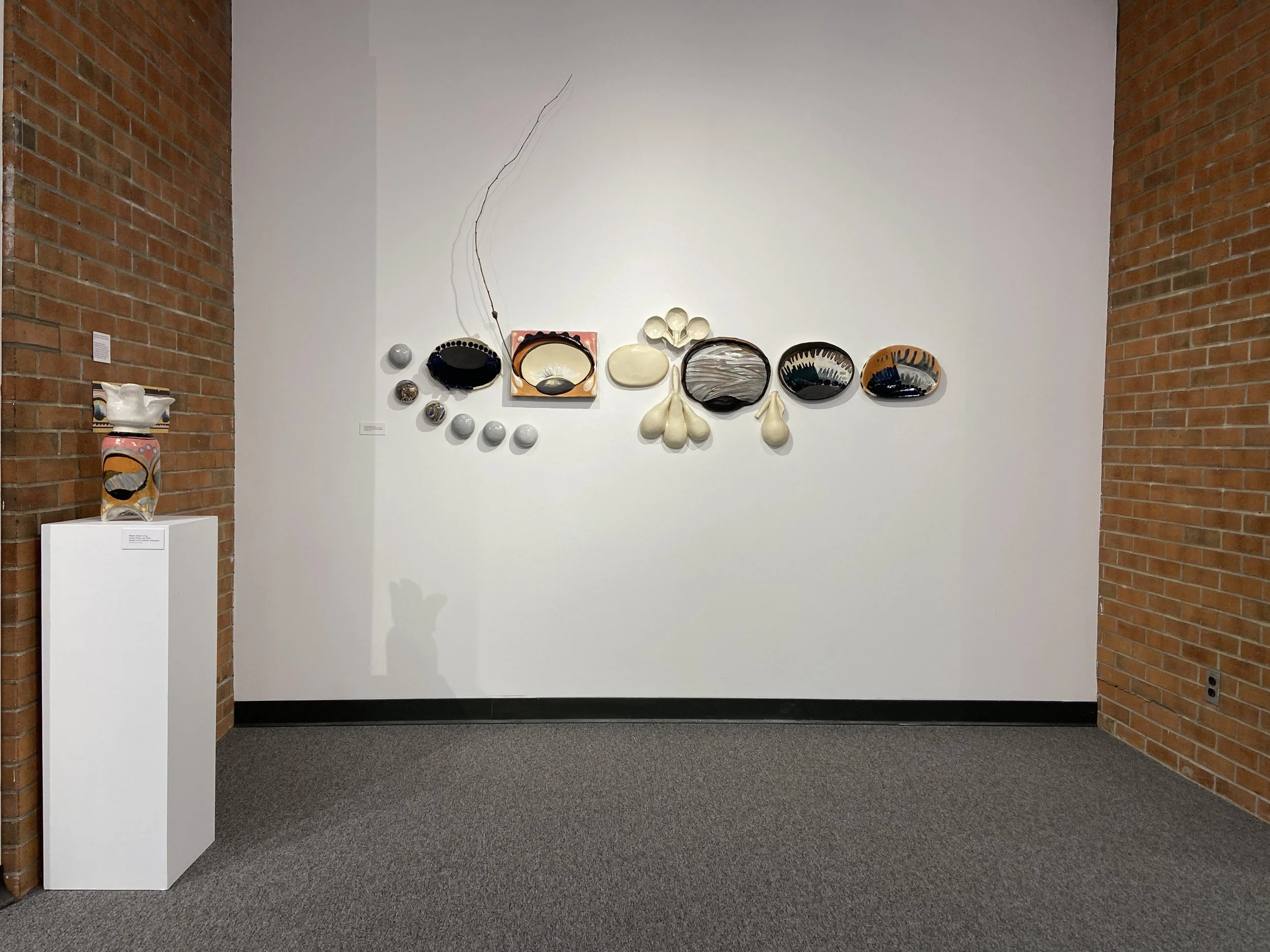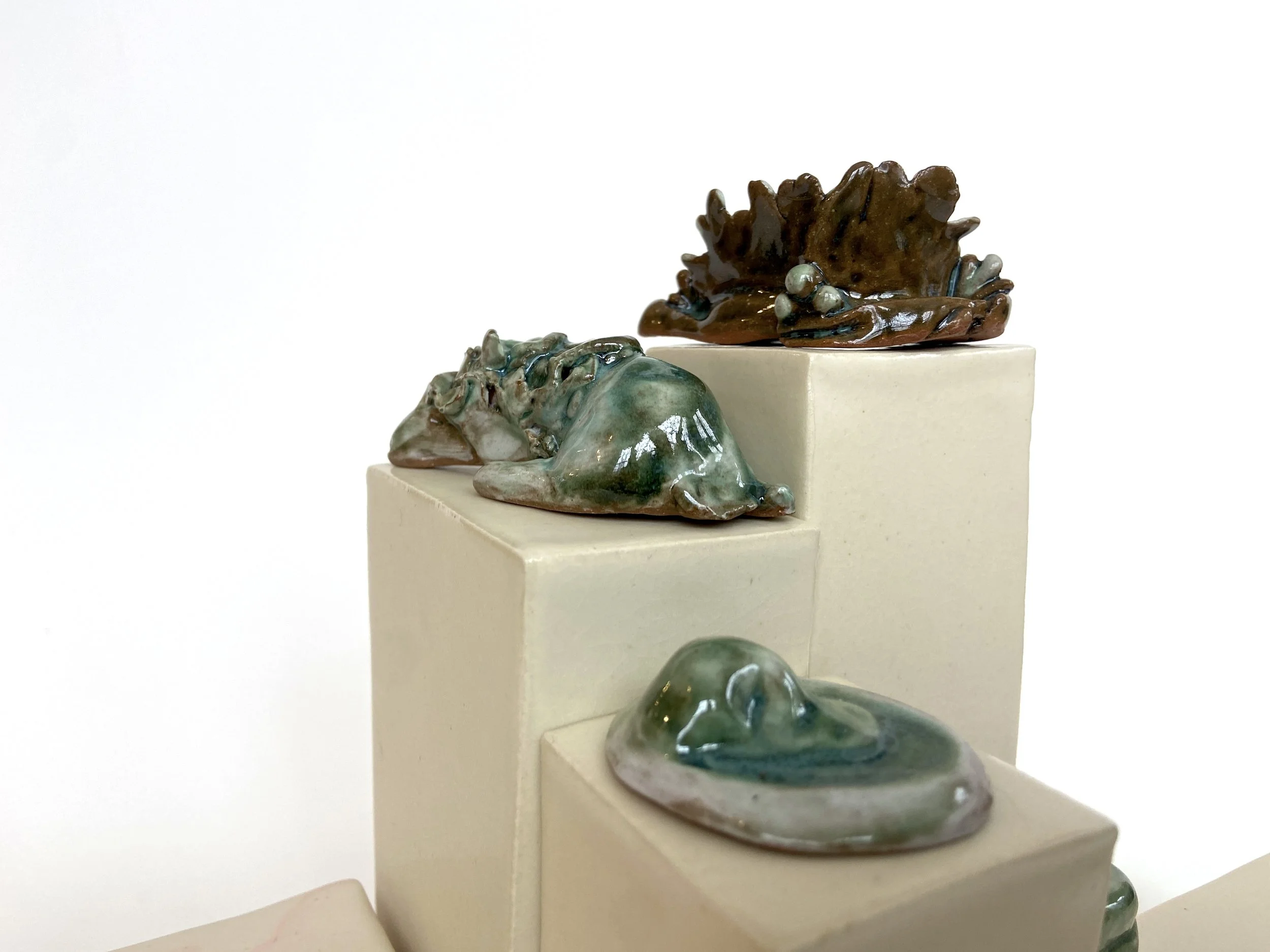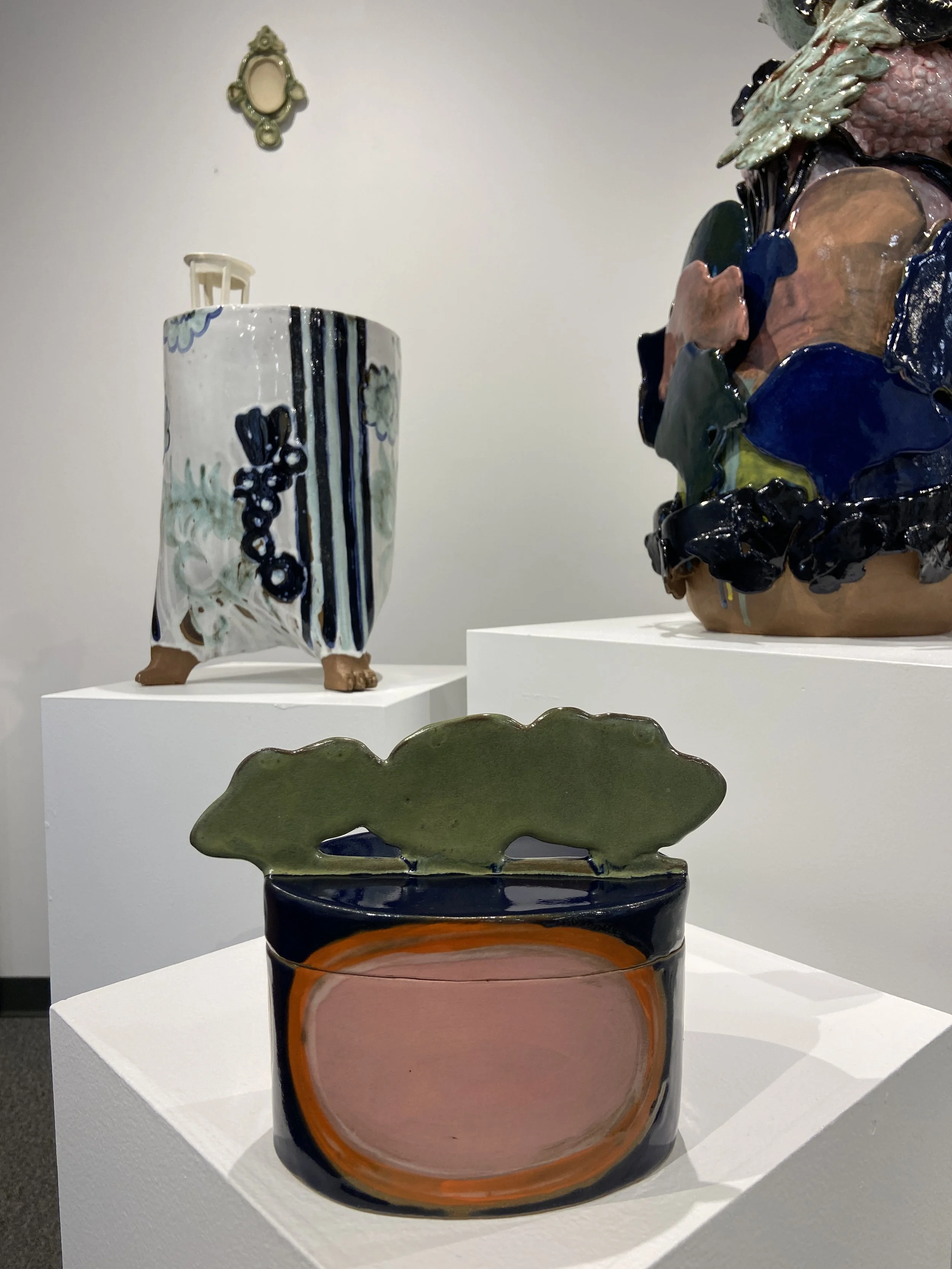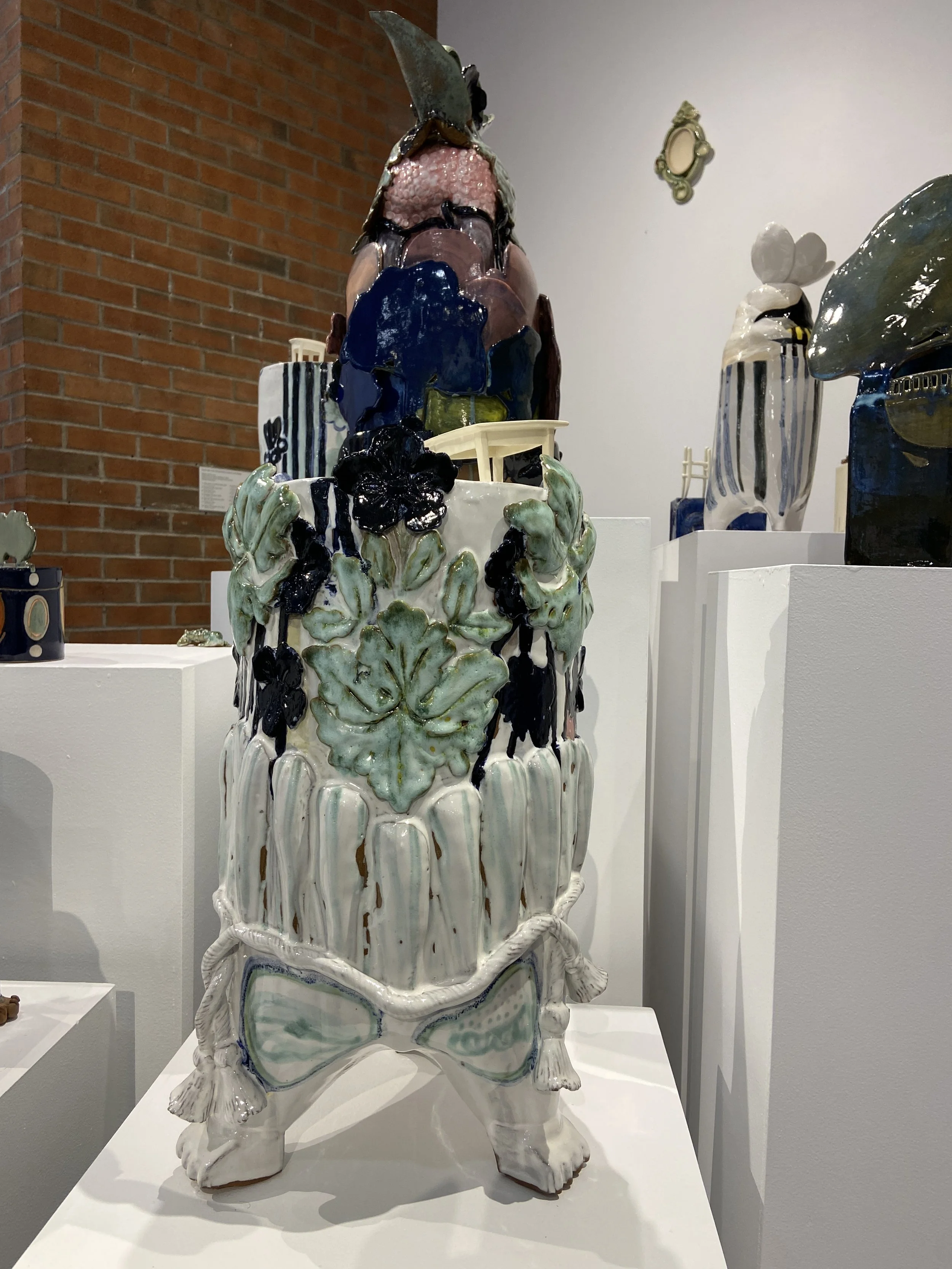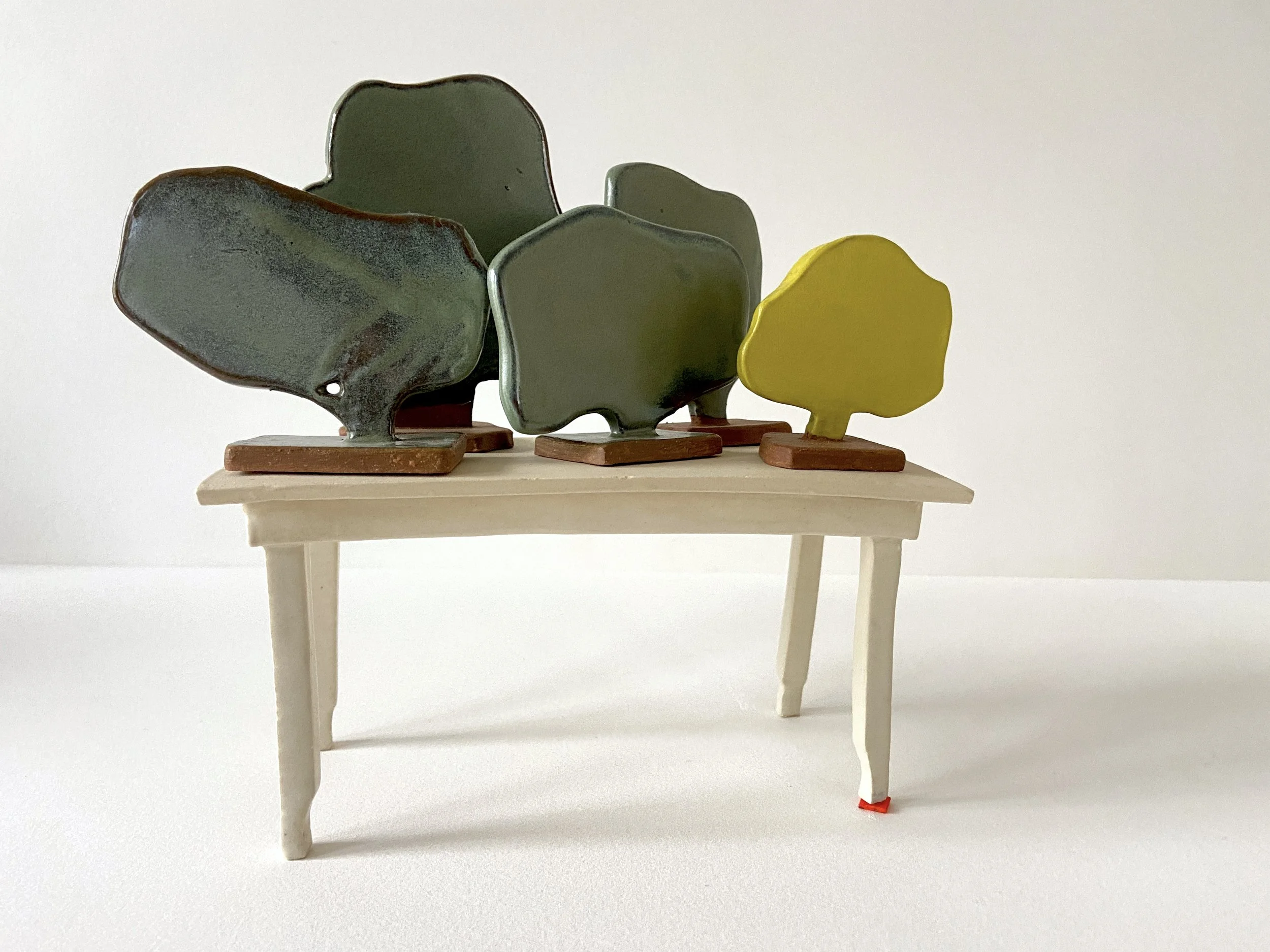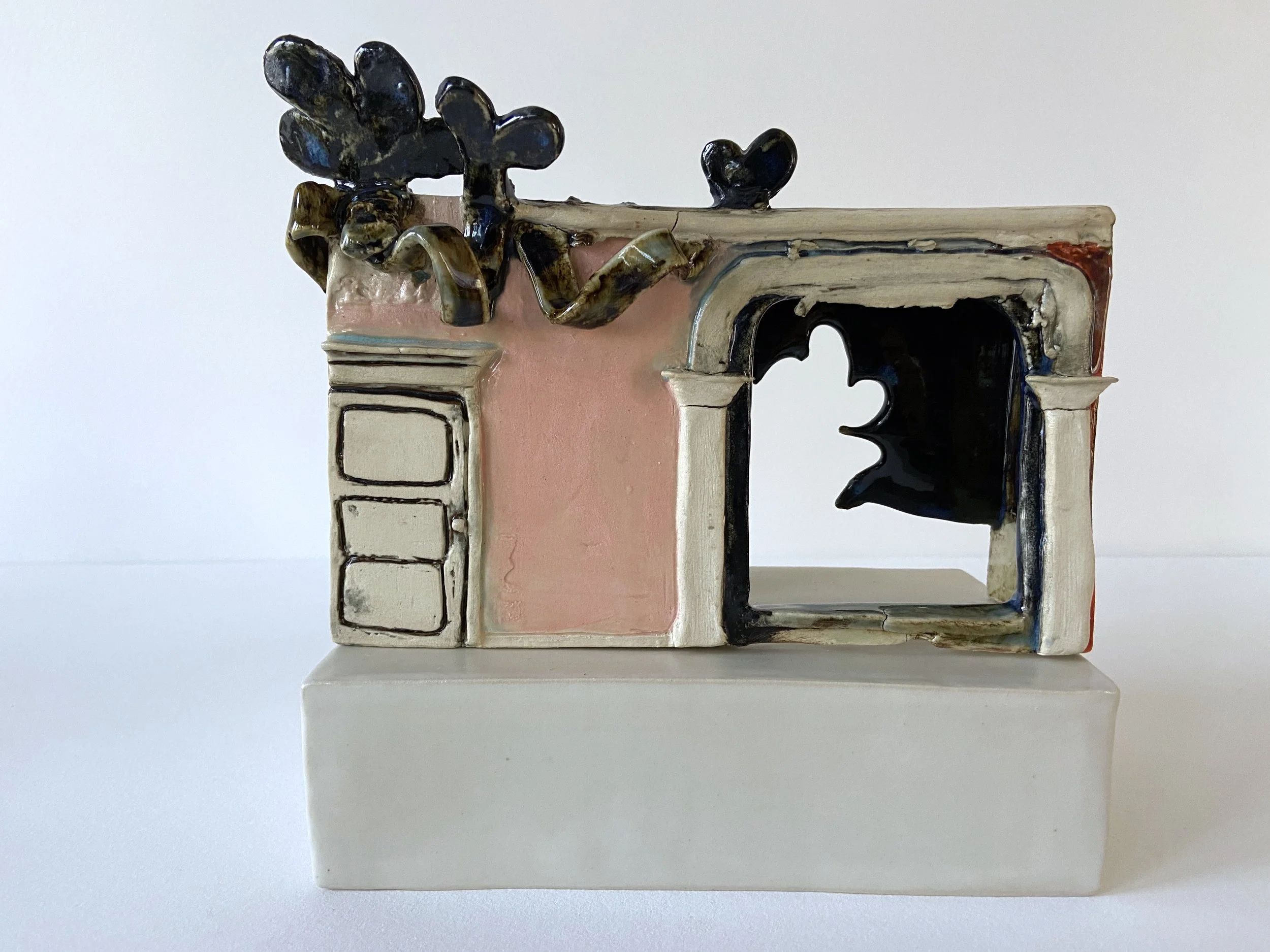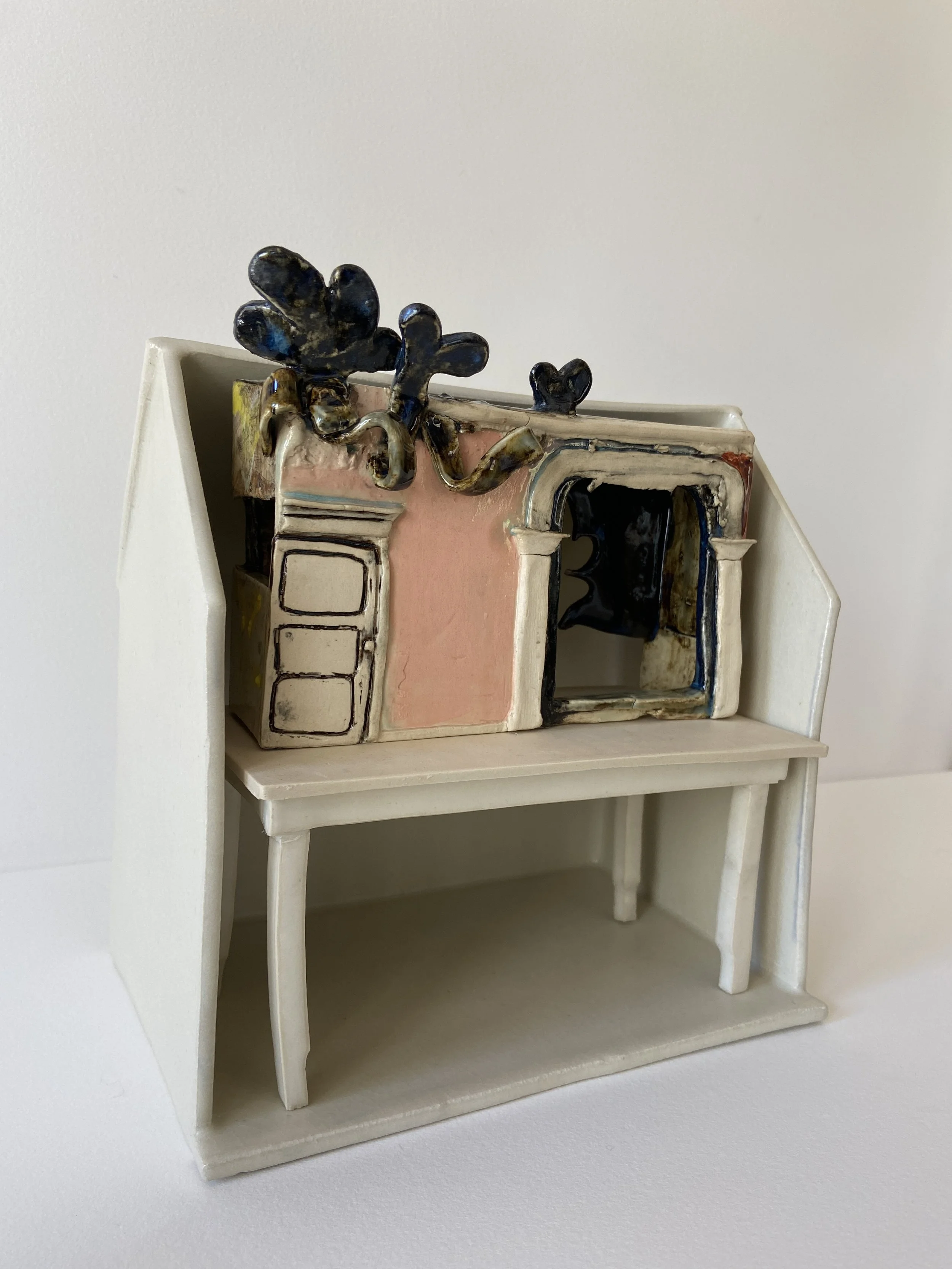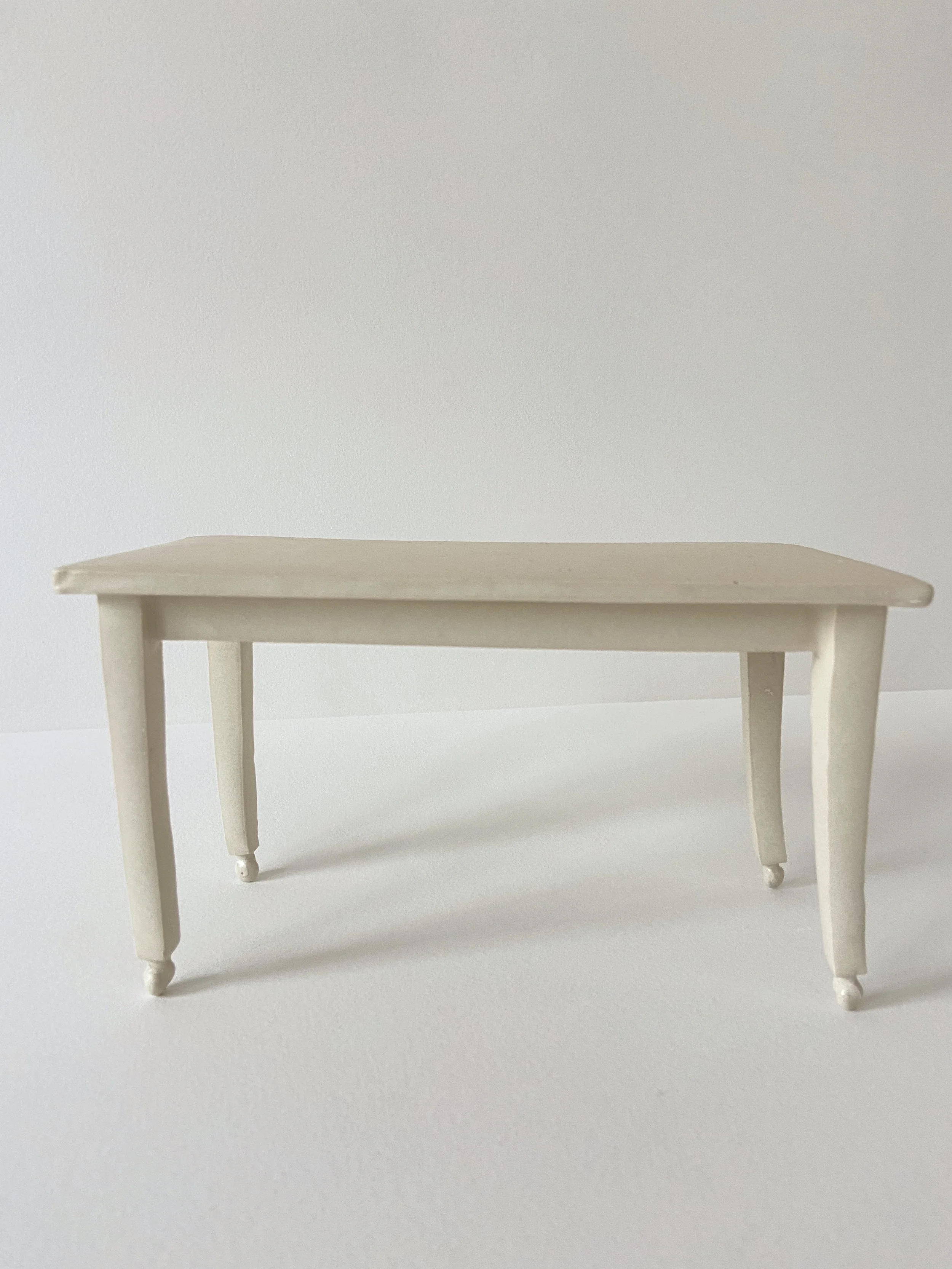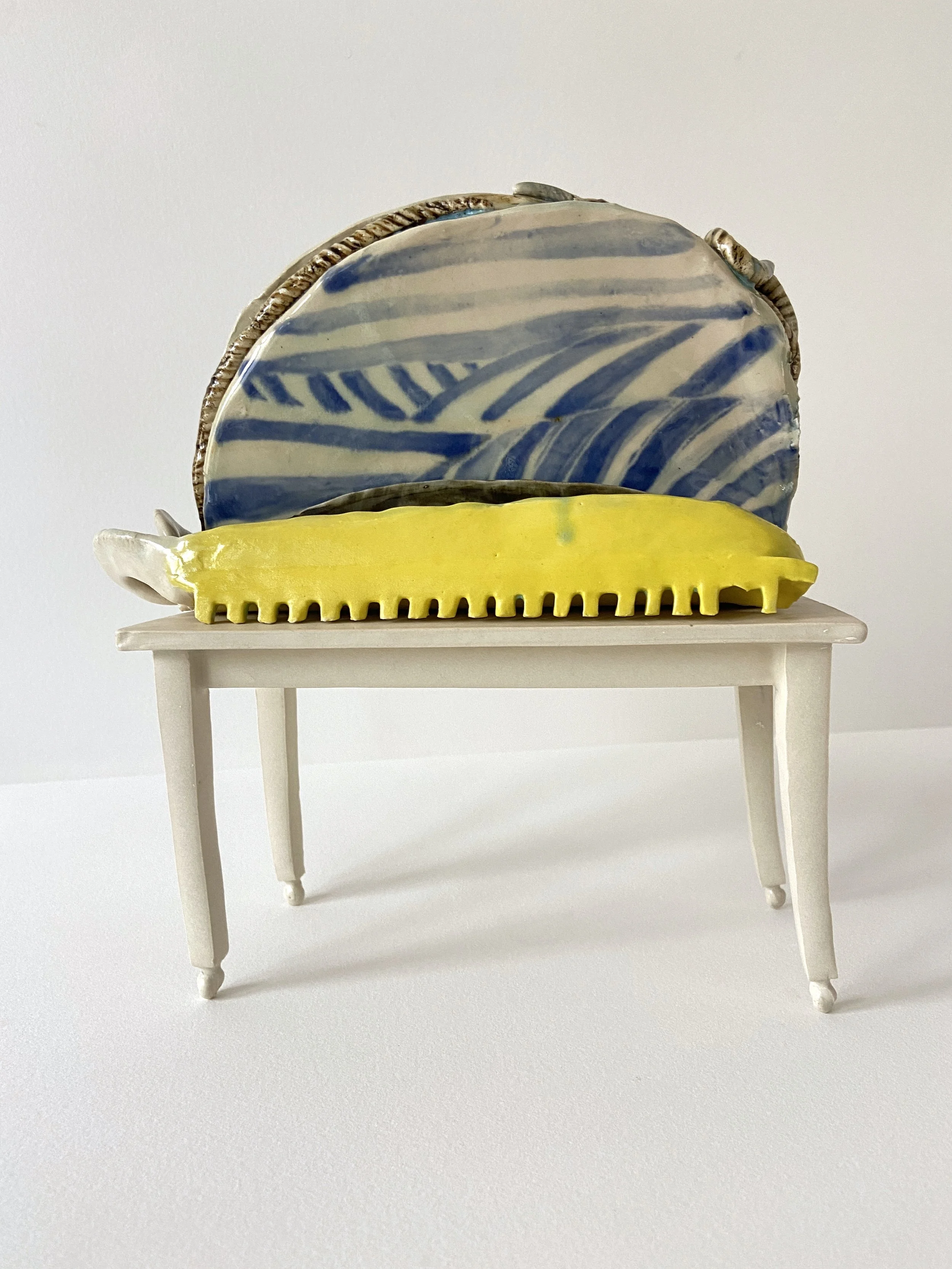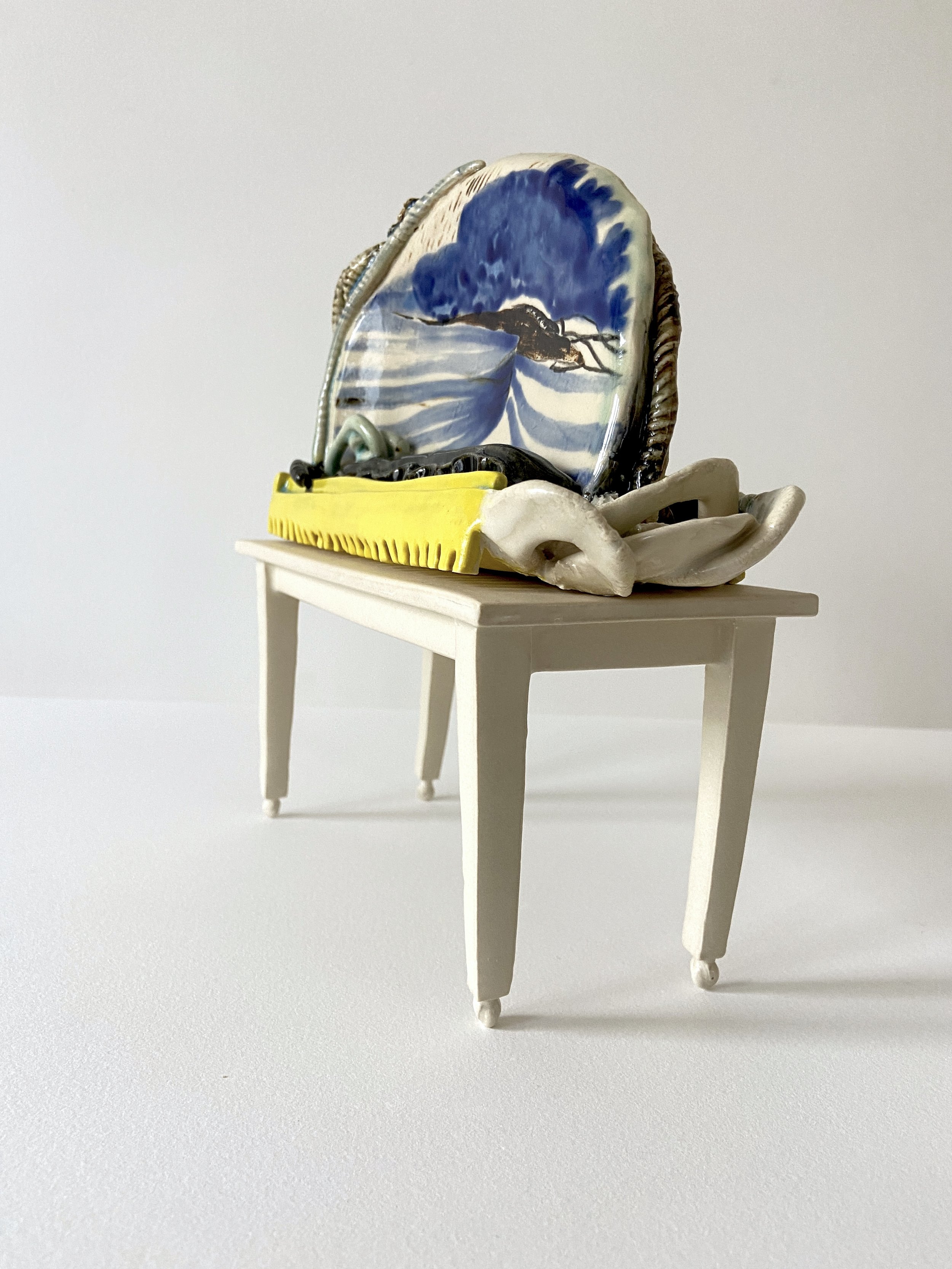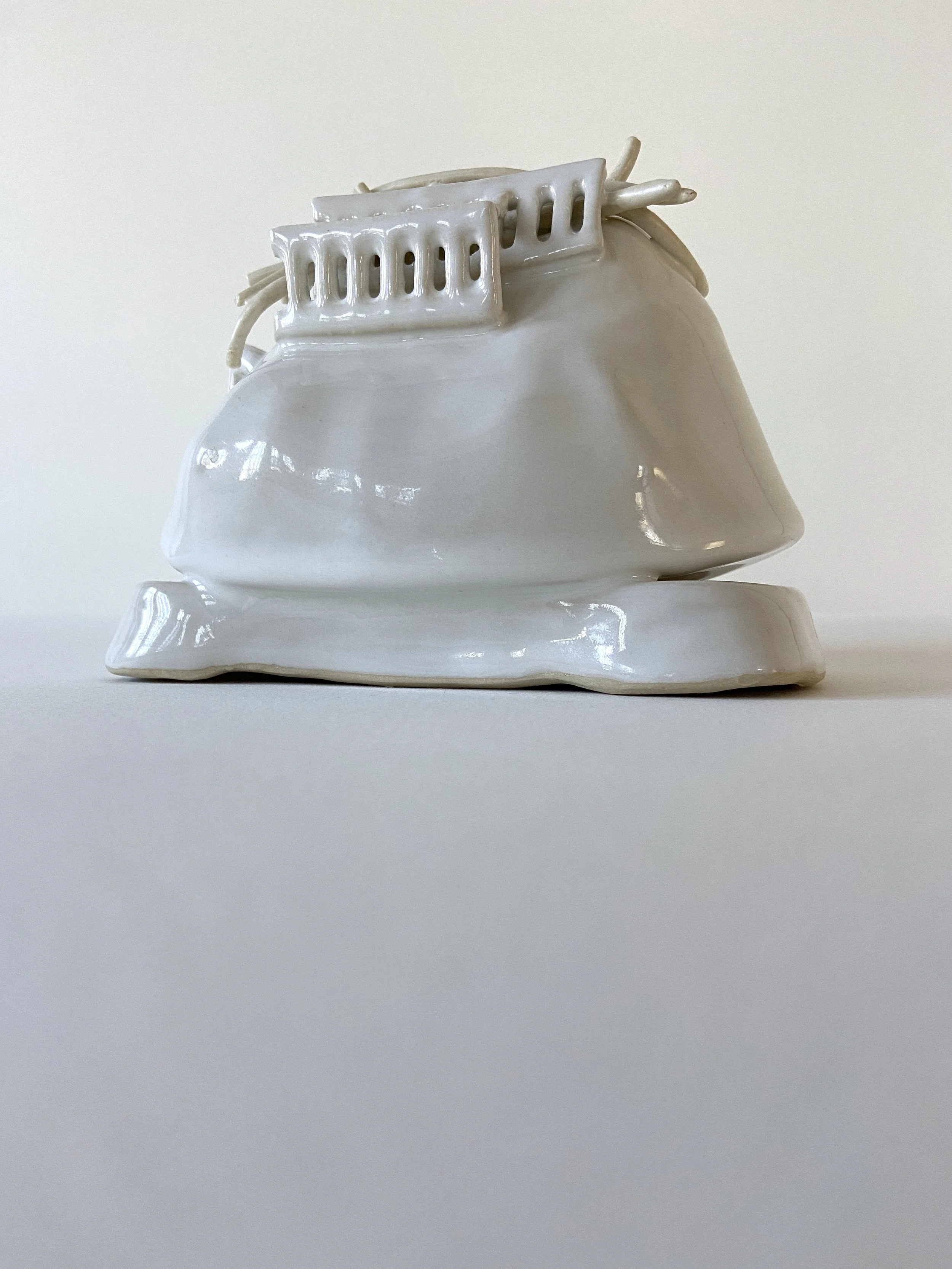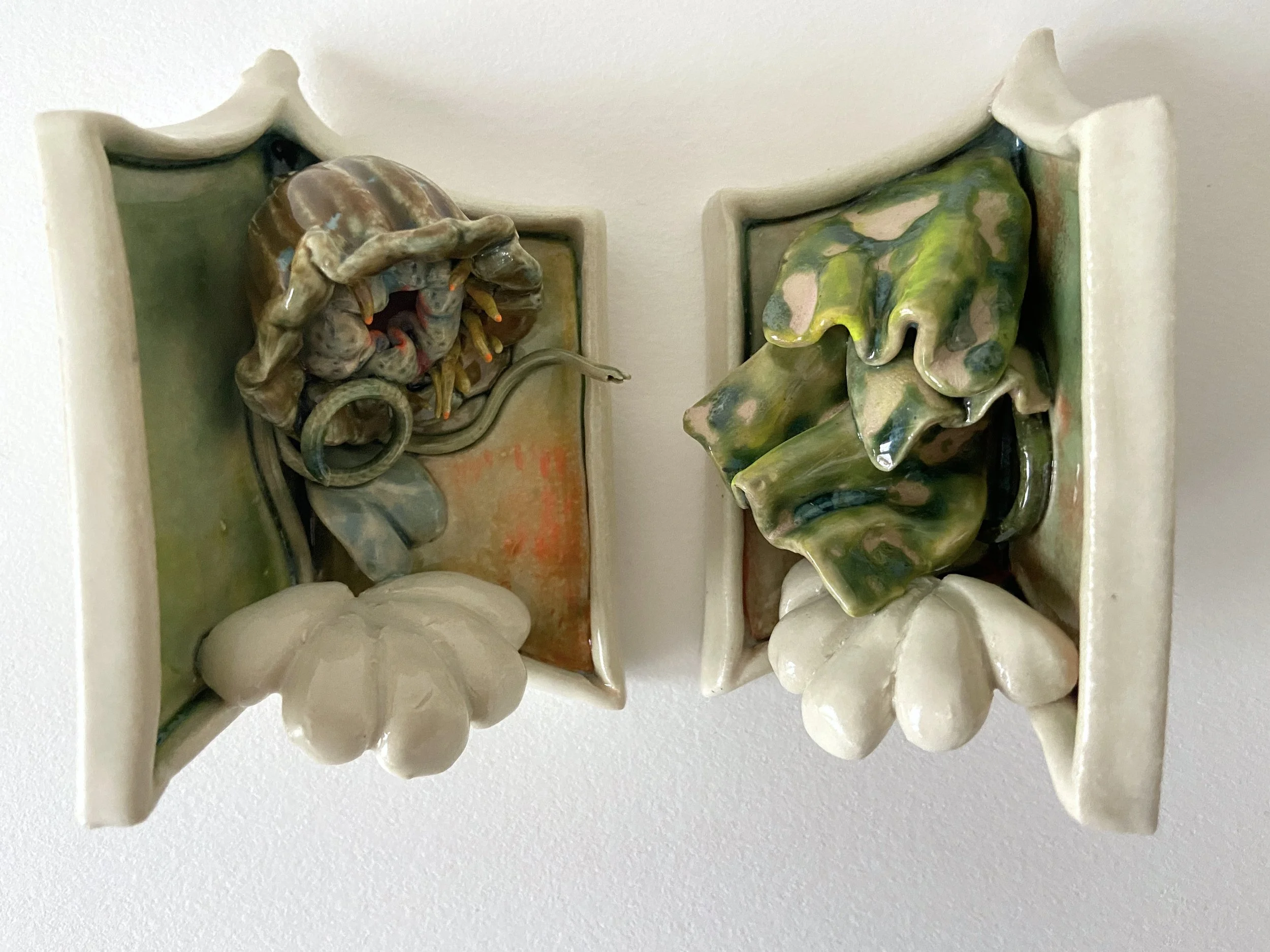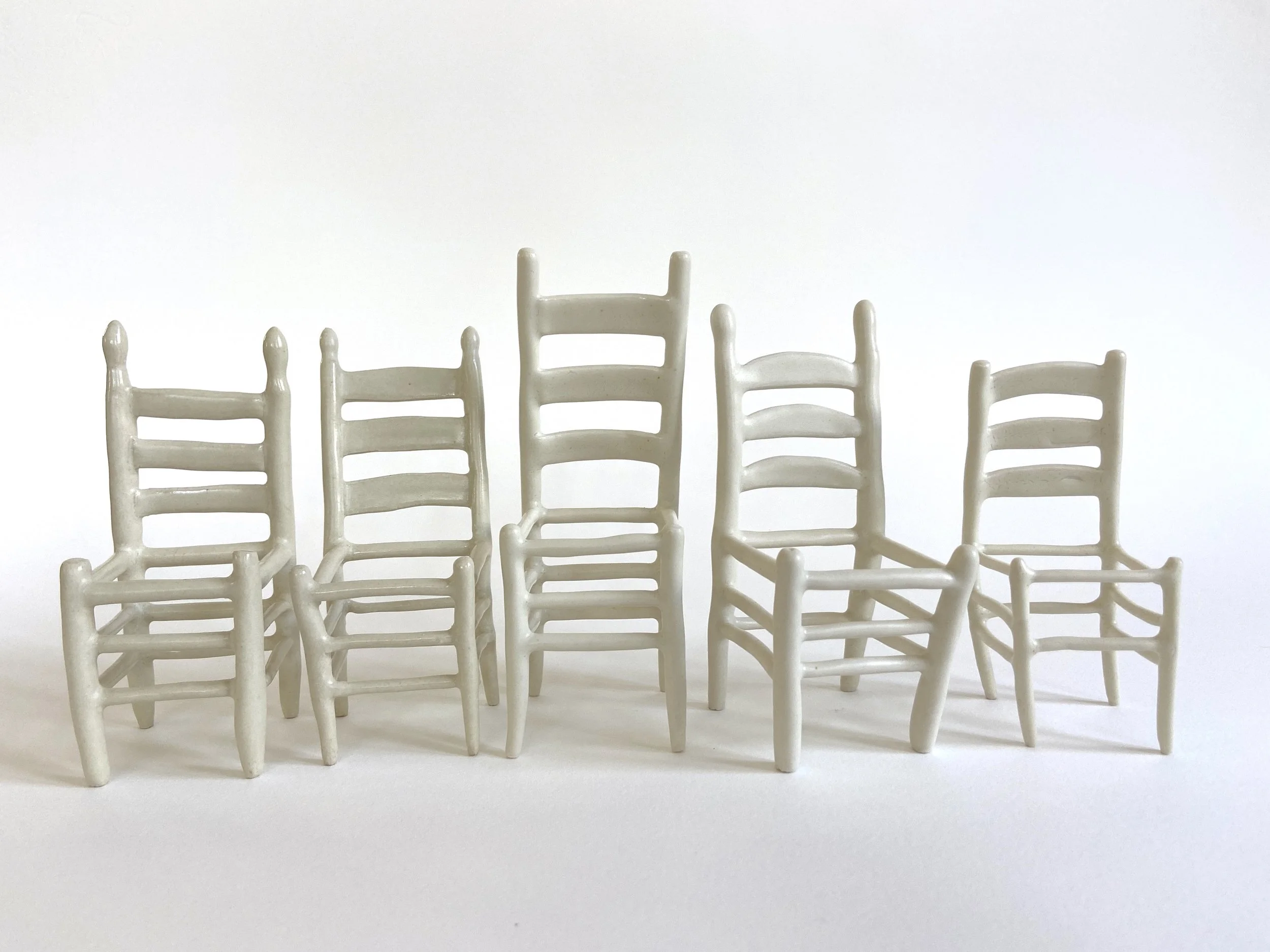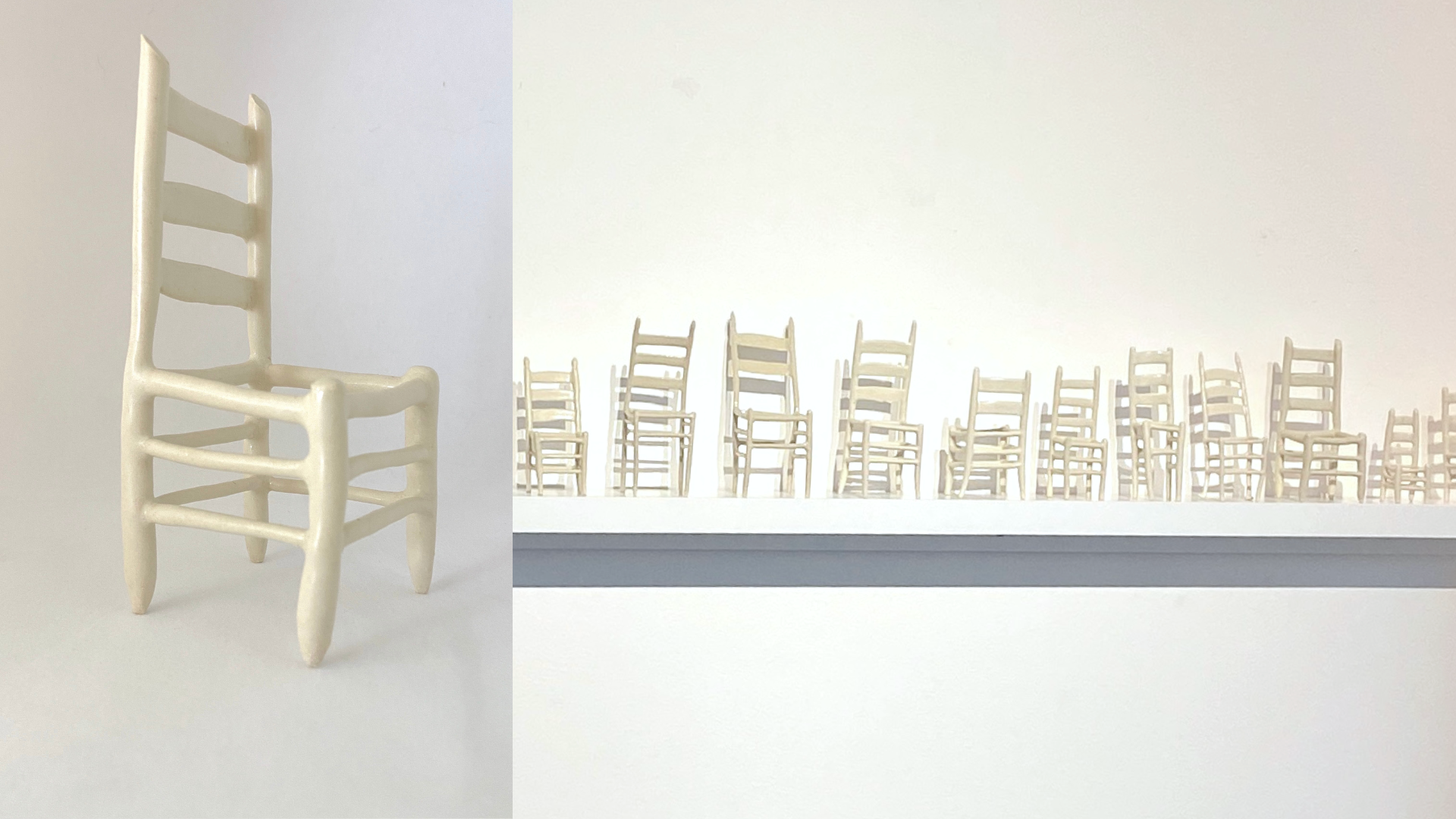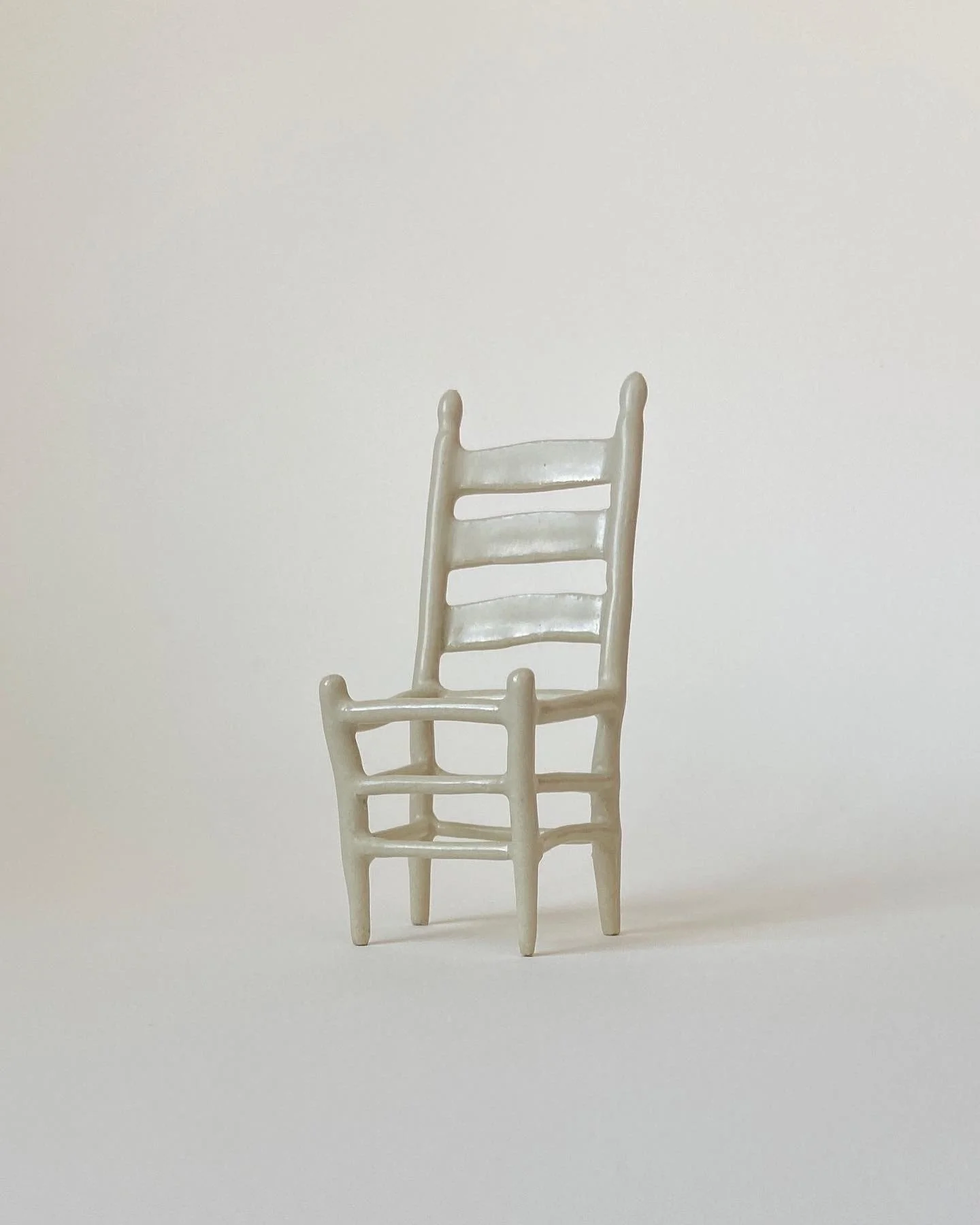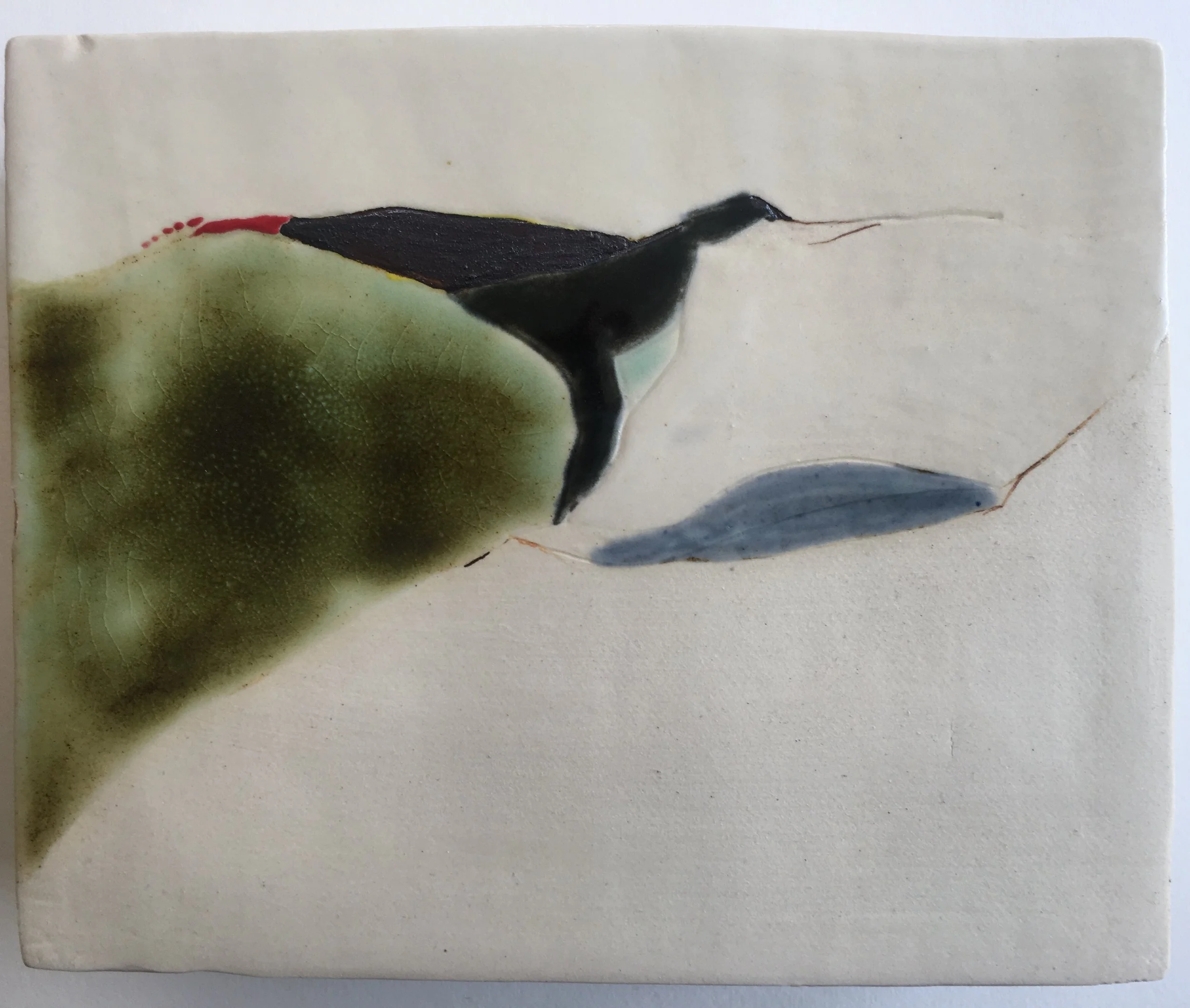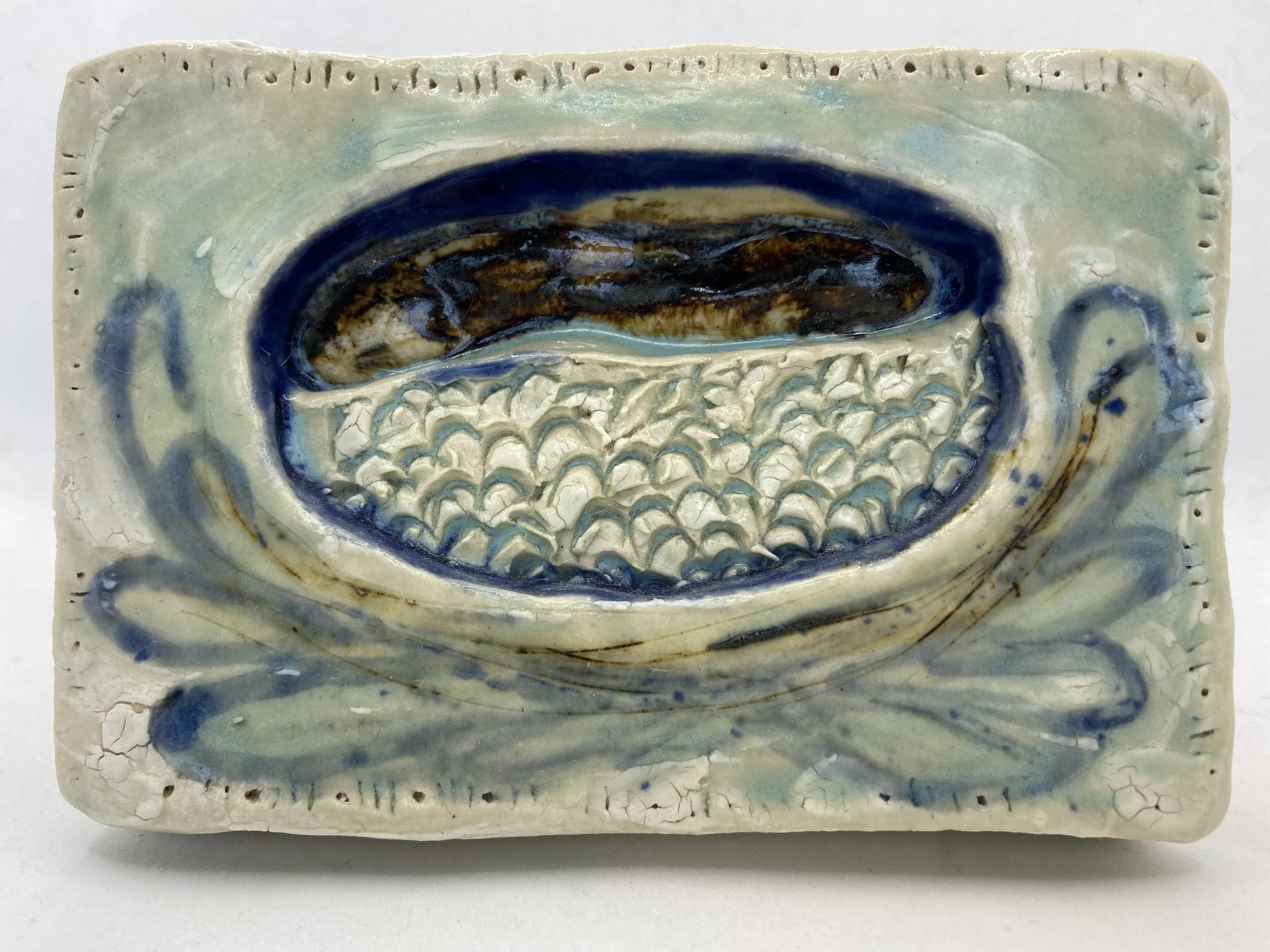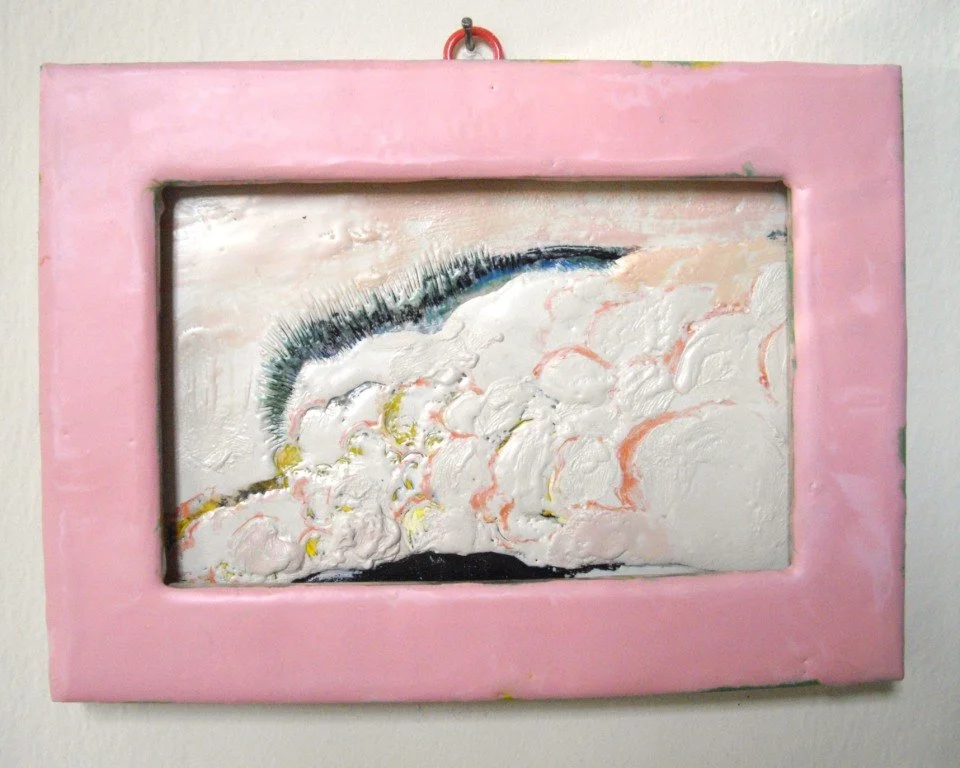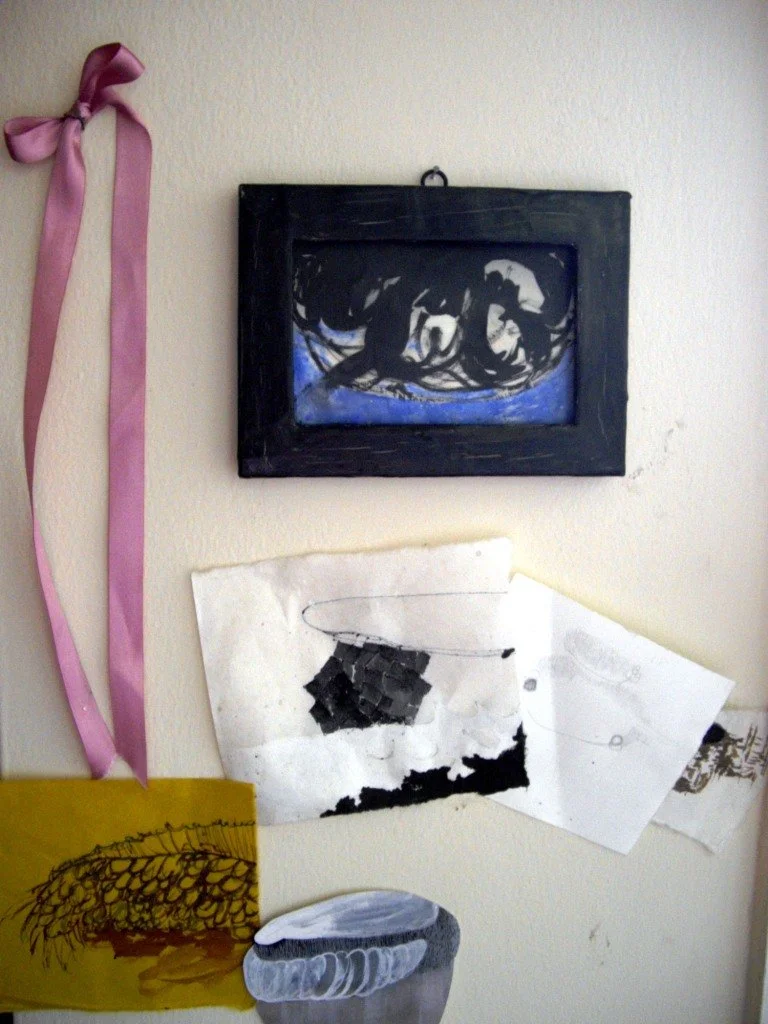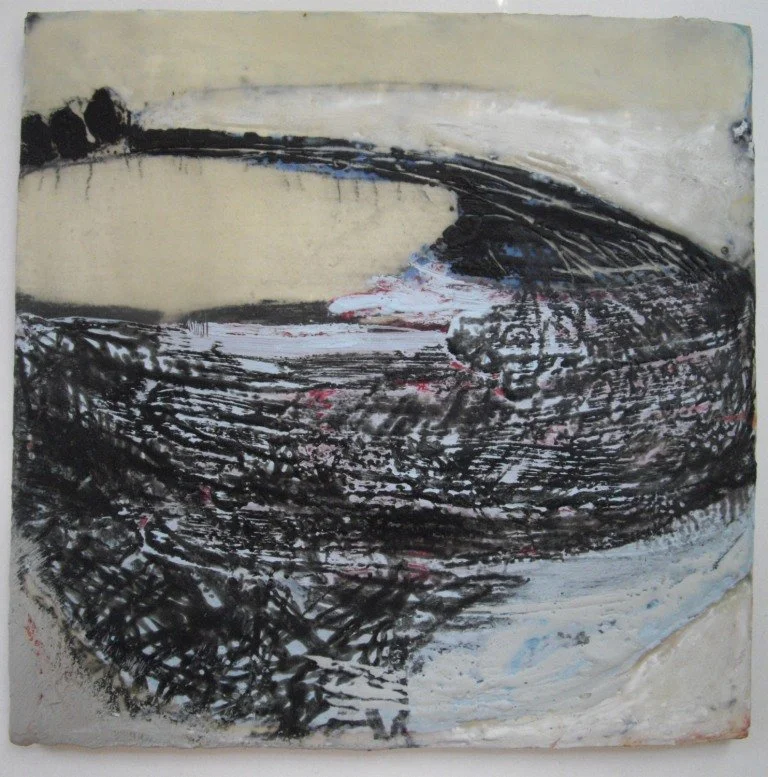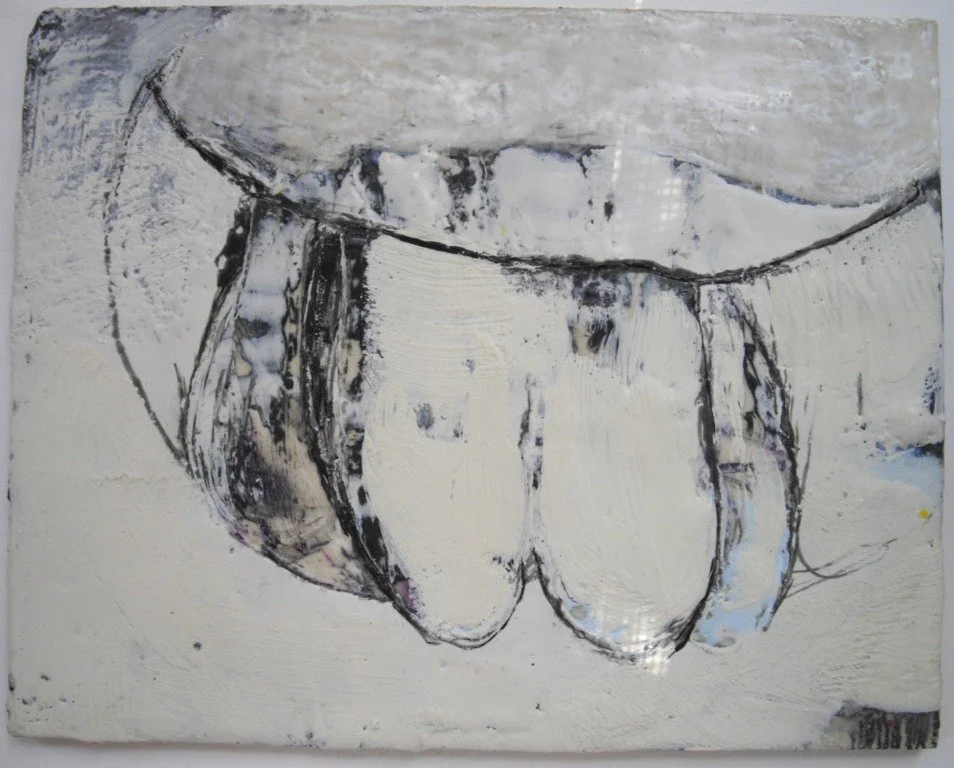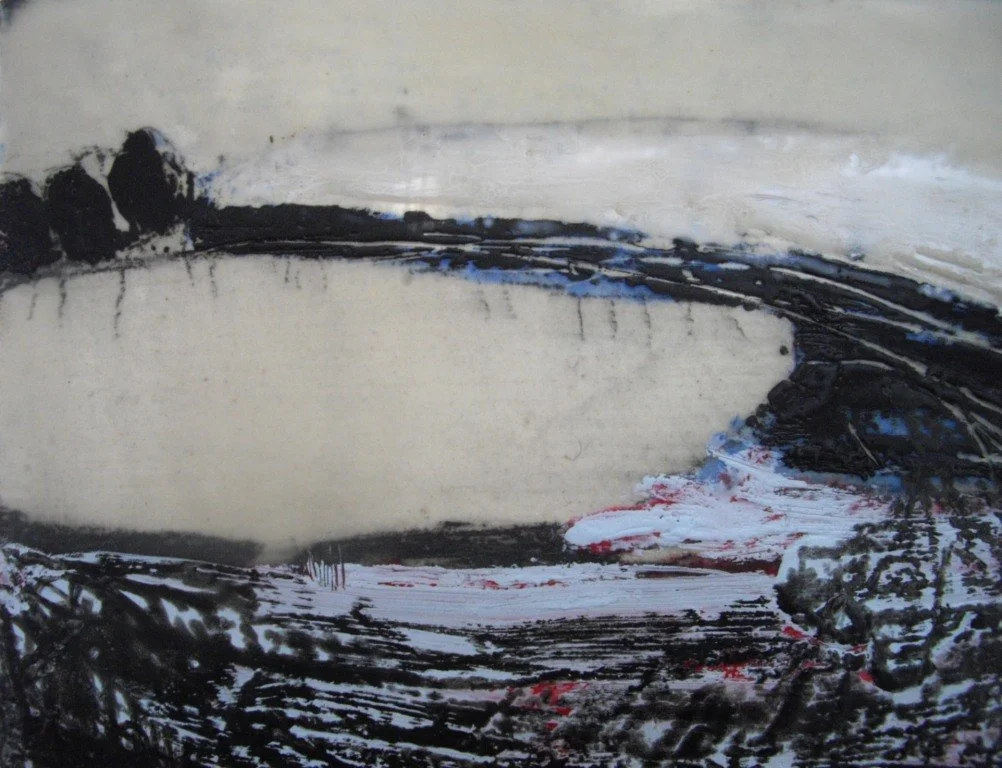Settings of Land and Dreams, July 2022 and Terrain, November 2022
ARTIST STATEMENT 2022
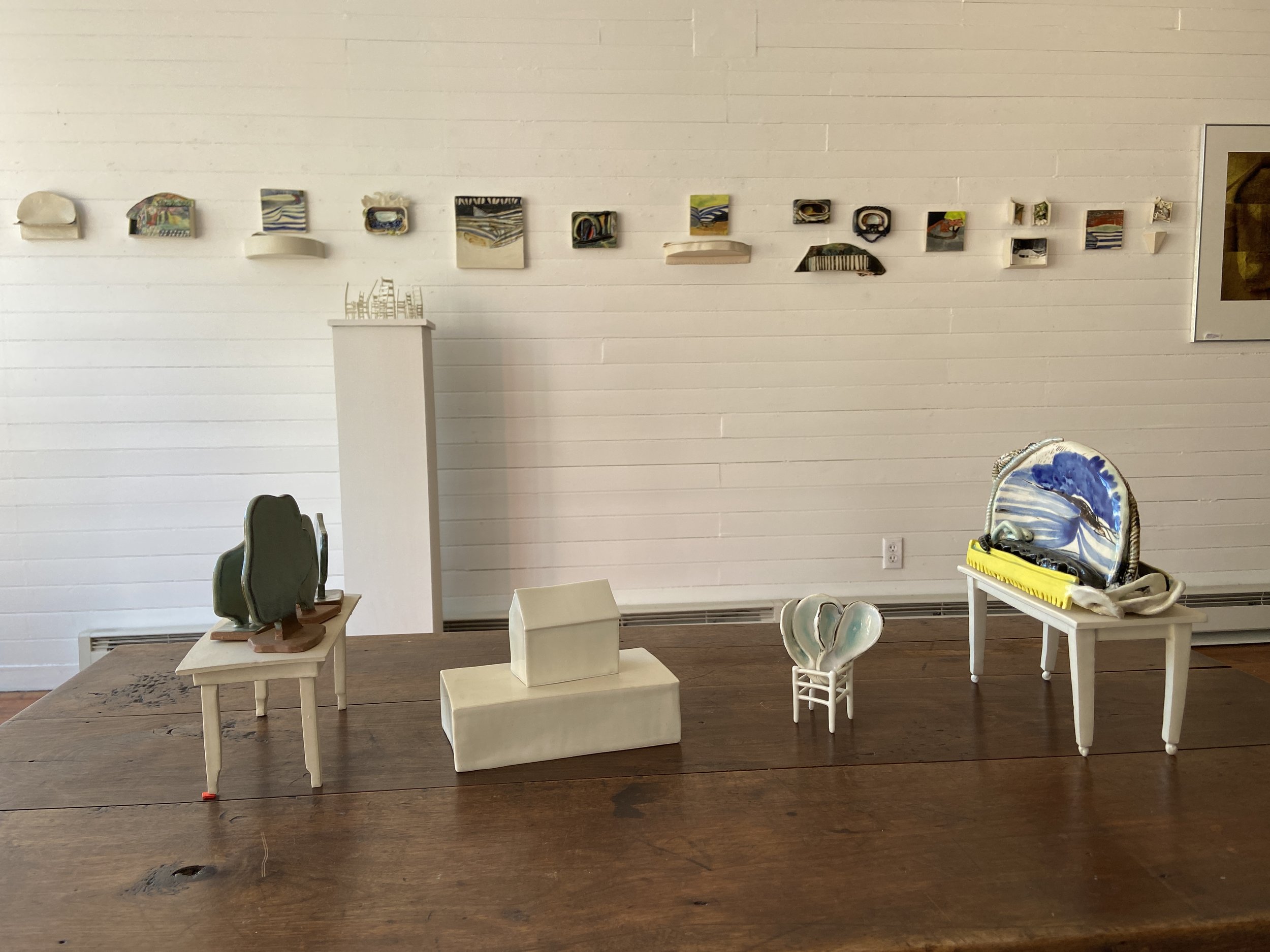
Ceramic is an unnerving medium, well suited to work that is at its core about the temporary and fragile qualities of life played in parallel to the persistence of nature and time. My work, even as a mixed media painter, has always been interested in the materiality of art making while exploring the edges of natural and human things. I use ceramic in all its material forms—liquid, plastic, solid but fragile—to make sculptures about painting and about landscape and about landscape painting. These small, often out of scale, or miniature pieces are aggressively handmade and though they approach topics like climate change and memento mori, they are not completely humorless or without joy.
Handmade objects representing human origin items remind us of the viewer, of ourselves, and of the possible actors who are not depicted but are implied in my work. They balance the emptiness in the landscapes because they remind us of play and of our complicated relationships with objects, especially those with historical or family significance, but they also accentuate a feeling of collective aloneness and separation from nature.
What happens to our collections—to all the things that have significance just because of who kept them, who made them, or the length of time they have been kept—when the context is gone? Family collections, or ordinary objects that have meaning to a small group of people, are a kind of invisible art and every human on the planet has some relationship with the objects they have accumulated in their life. Those objects and the activities around making them have created a layer of geology newly coined the Anthropocene, and it will be left behind in the long timeline of the earth even after we are gone.
Carbonate Remains 2020-2021
Artist Statement, Carbonate Remains 2020-2021
What happens to our collections, to all the things that have significance just because of who has kept them or the length of time they have been kept, when the context is gone. Family collections, ordinary objects that have meaning to a very specific group of people, are a kind of invisible art and every human on the planet has a relationship with accumulated objects in their life. Those objects and the activities around making them have created a layer of geology newly coined, the Anthropocene and it will be left behind in the long timeline of earth even after we are gone.
So let’s start at the beginning for a moment, a landscape, framed by an artist into a rectangle as a painting or screen, is a specific view with a viewer. I want you to think of landscape as setting for a story. It can be the story of your memories but geology is a story and weather is too. I want you to think about places you have been, who was there, what their home is like and what’s in it. Settings and objects are are essential to memory and storytelling and for a long time I have wanted to use objects outside of my paintings to show a relationship between human storytelling and the bare landscape. Since we all began to stay home more I think it has impacted our memories because everything happened in the same limited number of settings. For me it changed my relationship with the things that fill my home which led to the recent addition of unstable miniature furniture sculptures and decorative elements in my wall pieces. The objects and their obvious human origin, both in the object depicted and the evidence of the hand in making them, remind us of the viewer, of ourselves, and of the possible actors who are not depicted but are implied in the paintings. They balance the emptiness in the landscapes because they remind us of play and of our complicated relationships with objects, especially those with historic or family significance, but they also accentuate a feeling of collective aloneness and separation from nature.
Sticks and Stones 2018-2019
Sticks and Stones 2015-2017
-
If a painting is a path to insight into the inner story of the painter, then the painting is a reflection of a truth that should resonate with other people. I may be referencing my experience and using my visual language when painting, but I’m thinking about themes with a broader, more universal reach. The ideas from those thoughts make it into the work but are not always exactly as I plan or originally envision. I get to this space through other storytelling mediums like television, film, or journalism. I’m particularly fond of any kind of historical drama set on a craggy coast where the landscape, and all its moody panoramas, is a main character. Those shots and my paintings can show something to the viewer—a story—without words or emotion but on which life on earth is dependent. My recent work was set in motion by a very simple story that opened a door of curiosity. It was a social listing in an old local newspaper, and I think the date was January 1904. It was a very short story that I could never find again, but it went something like, “______ departed from New York to Jamaica.” It was 1904. There is so much to imagine there—the boat they traveled on, getting to the port in New York, closing up their Summer home in Richfield Springs, where they stayed when they got there, why they went? So, the work I made around it and these well-off people in the past took off, mixed with my interests and concerns for the present and future. The work is about ideas around the migration of people because they have to or because they want to, it’s about land and soil, what the food is like, what they left behind and what they found or who they met in another place. I am romanticizing it all, it’s true. These are dreamy, lost coastlines maybe they are full of tragedy and fear, but you can’t literally see any part of the human story. You can just look at the erosion, the changing geometry of the earth, and the sky that slides into the water. The ground under our feet may be moving, going underwater, or under siege, so the people and animals move too. Their relationship to place changes once they are in motion. These places I’m painting are very empty, and it may be that they are uninhabited, but it may also be that we are just seeing them from too far away to be able to see if there are some hopeful inhabitants there creating new ventures or sustaining generations of culture. Likewise with the empty nests. They might be abandoned when we are looking at them, but that doesn’t mean that’s the whole truth about them. The whole story is not available.
It was 1904. They went to Jamaica.

Sites 2012-2014
For the most part I am a landscape painter. I paint very large and very small works in oil, encaustic, and watercolor. I am particularly enamored with the physical properties of my materials – drying versus cooling, waterproof versus soluble, liquid versus solid. They are all seductively beautiful as individual ingredients. I work and make decisions slowly, patiently.









